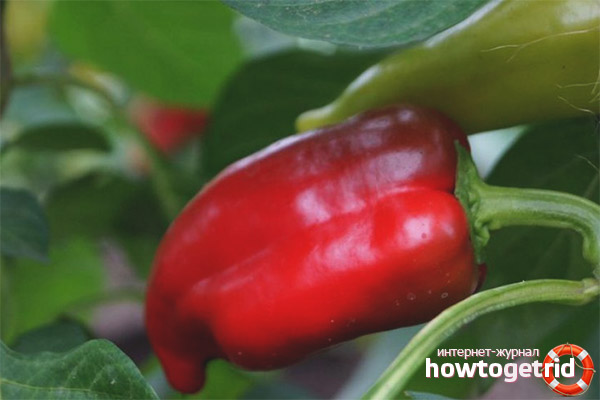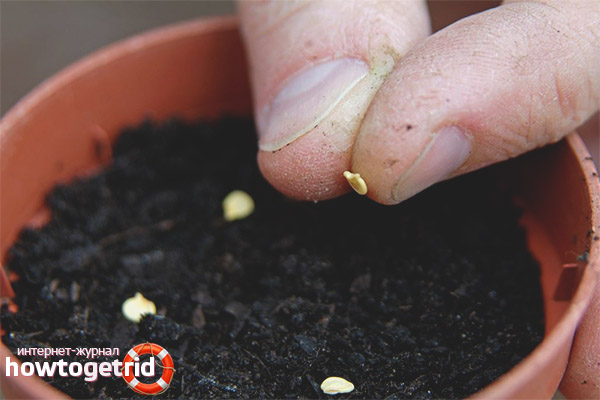The content of the article
Those who love sweet peppers will surely appreciate the Pinocchio F1 hybrid. It is well resistant to most diseases, unpretentious and gives a good harvest, starting from the moment of ripening of the first peppers, and until mid-autumn inclusive.
Variety Pinocchio: description
The “Year of Birth" of the variety is 1995. It was then that it was first planted in open ground in the temperate climate of Central Russia. Pepper showed such good results that it quickly spread throughout the rest of the country. The variety can equally well be grown both in the greenhouse and in the open. Fruits ripen early - about 3 months after sowing seeds for seedlings. Bushes do not grow very high - up to about 1 meter.
Plants do not need a garter, they are branched, sprawling, leaves are dark green in color, slightly rough. You do not need to form a bush, it grows as it is, by itself. The trunk is strong, usually has several shoots.
The fruits are quite large, have the shape of a cone, slightly elongated. One fruit weighs an average of just over 100 grams. The wall thickness is approximately 5 mm. The taste does not differ in originality - usual for sweet pepper, juicy.
An important point: the plant bears fruit very well in a temperate climate. Because of this, the variety is popular in Russia, Ukraine and Belarus.
Pinocchio seeds germinate well, the percentage of losses is minimal. Variety of average productivity - up to 13 kg of fruits per season can be obtained from the bush. Pepper resists diseases well, tolerates the vagaries of the weather: heat, strong winds and showers.
Distinctive features of Pinocchio variety:
- Average yield.
- Fruits of the same size, very large.
- It has increased resistance to rot.
- The variety is not demanding on climate conditions.
- The harvest is stored for a long time, the fruits well tolerate transportation over long distances.
- Plants grow well and bear fruit in shaded places.
Growing conditions
The hybrid is considered to be early ripening, since it brings the first fruits about 3 months after the first seeds are planted in the ground. If you grow peppers in a greenhouse, then mature vegetables can be harvested after 80 days. For all its unpretentiousness, Pinocchio nevertheless produces better fruit in the warmth; therefore, growing in a greenhouse or in a greenhouse, it brings more crops than in open ground.
Seedling for seedlings
Since the variety is early, seedlings begin to be engaged in late February - early March. Of course, to get good, strong seedlings, you need to choose the appropriate seed material. To separate high-quality seeds from low-quality, they are thrown into a strong saline solution. At the same time, bad seeds float to the surface, good ones do not.
It is highly advisable to process the seeds before planting. There are several ways to do this (select only one from the list):
Keep the material for several days in room temperature water.
- Rinse with a weak solution of potassium permanganate.
- Treat with 40% hydrogen peroxide solution.
- Buy in the store a seed growth stimulator.
- Treat with a solution of wood ash.
Simple soil from a bed for growing seedlings is not suitable. Its composition should include many trace elements and fertilizers, so it is better to buy land in a specialized store. However, if desired, the soil can be prepared independently. To do this, peat, sand and earth are mixed in equal proportions, and a little humus is added as fertilizer.
The containers are filled with finished soil, seeds are planted, the boxes are covered with transparent plastic wrap and placed in a warm, lit place. The temperature of the soil should be at least +15 C. The seed is periodically watered with warm water and try not to expose it to drafts.
As soon as the first shoots appear, they must be periodically ventilated by lifting the film so that excess moisture does not accumulate inside and the plants breathe.
After about 3 weeks, the film or protective glass can be removed. By this time, the plants should already be quite strong. Now they need to be fed with mineral fertilizers.
An important point: since at the end of winter and the beginning of spring the daylight is still not long enough, and there is little light for seed germination and plant development, it is necessary to provide them with a source of additional lighting. Plants dive after the first leaves appear on them. Each bush is placed in a separate cup of sufficient size so that the roots are not crowded in it.
After the seeds germinate, you need to make sure that the temperature in the room does not fall below +20 degrees. The best temperature for the full development of seedlings is + 25- + 27 degrees. Before planting in open ground, young plantlets should be “hardened". For this, the room temperature begins to gradually decrease, and immediately before planting in the ground, the boxes are taken out into the street.
Planting young plants
Young bushes can be planted in the garden no earlier than mid-April, when the night frost stops. A separate hole is prepared for each bush, adhering to a distance of about 40 cm. The distance between the beds should be at least 50 cm. No more than 7 plants should be located per 1 m2.
An important point: Buratino pepper must be planted separately, there should not be bushes of pepper of other varieties nearby. Pinocchio pepper is a self-pollinated plant and can interbreed with other varieties, which will lead to a deterioration in taste.
How to care for bushes
The Pinocchio variety is not particularly demanding, and when growing it, you should only loosen the soil in time, water and fertilize the plants. The right choice of beds is very important. The fact is that the roots of Pinocchio are weak, and a strong wind can damage the plants. Therefore, it is very desirable to plant pepper in a place protected from strong winds so that they do not die.
To pollinate plants more efficiently, on hot, calm days they need to be shaken periodically. Pinching plants is optional, but if desired, beautiful bushes can be formed. The crown flower, which is formed first in the very center of the plant, must be removed.
As mentioned above, pinching bushes is optional, but practice shows that this procedure has a positive effect on yield. In addition, if the bush grows lush, it will protect the soil near excessive heat.
Bushes are fed only three times: immediately after planting, during flowering and after the appearance of the fruit. For feeding, chicken manure, wood ash and mineral fertilizers are used. With proper care and timely fertilizer of plants, they practically do not get sick, but they can be attacked by various kinds of pests.
One of the most dangerous insects for peppers is aphids and spider mites. Fight them with insecticides or alternative methods. Also, to destroy the tick, you can use a solution of laundry soap, garlic and dandelion leaves.
As is clear from the foregoing, there is nothing complicated in caring for Pinocchio pepper, and subject to simple rules, you can harvest a good crop every season.
Video: pepper Pinocchio F1












Submit